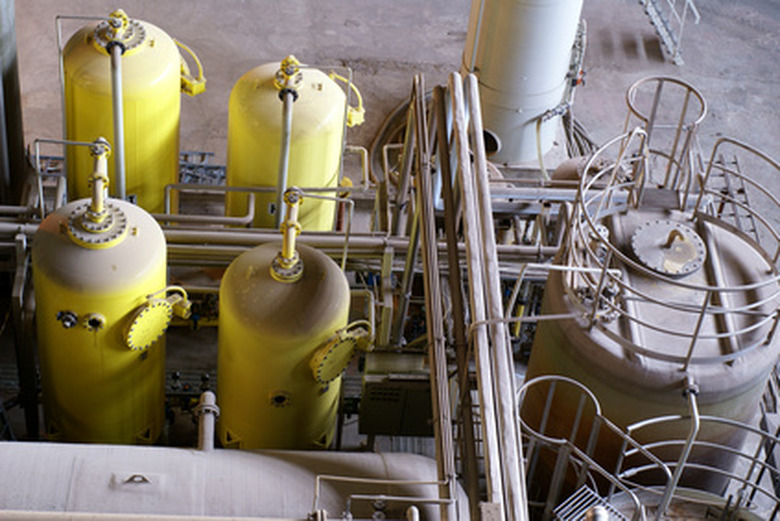Potassium Permanganate Water Treatment
Potassium permanganate, or KMnO4, is a common inorganic chemical used to treat drinking water for iron, manganese and sulfur odors. It can be used as a disinfectant as well, keeping drinking water free of harmful bacteria. Drinking water facilities commonly use potassium permanganate in the early part of the disinfecting process to reduce the amount of later disinfectants, like chlorinated compounds, that must be used.
Iron and Manganese Removal
Iron and Manganese Removal
If the amount of oxygen in drinking water is low, iron and manganese may stay in the solution. Both metals cause dark colors in drinking water that may be harmful to plumbing fixtures and laundry. Potassium permanganate is commonly used to remove them. Potassium permanganate oxidizes iron and manganese, causing the metals to precipitate out of the solution. Iron is converted from a ferrous–two-plus electrons–to a ferric state–three-plus electrons), while manganese is converted from a two-plus to a four-plus state. This reaction takes about five to 10 minutes in drinking water that has a pH at or above 7.00.
Odor Control
Odor Control
Organic matter can cause unpleasant odors in drinking water. Examples of this can be found especially in water taken from a lake or a well. Potassium permanganate can be used to neutralize these smells and disinfect the drinking water at the same time. KMnO4 can be found at chemical warehouses or pool stores for use in treating drinking water. The pure form can be toxic and dangerous. A professional in the water treatment and regulation field should be consulted before self-treating any drinking water.
Control of Nuisance Species
Control of Nuisance Species
Potassium permanganate has been found to control some species of fresh water mollusks that pervade drinking water reservoirs. According to the Environmental Protection Agency, juvenile Asiatic clams can be controlled at a potassium permanganate concentration of 1.1 to 4.8 mg/L. It is also useful for killing zebra mussels, another invasive species. The concentration needed for this is approximately 0.5 to 2.5 mg/L.
Reducing Disinfection Byproducts
Reducing Disinfection Byproducts
Potassium permanganate is very valuable as a drinking water disinfectant. Unfortunately, it is not as cost effective as other more widely used disinfectants, like chlorinating reagents. The byproducts from these various chlorinating reagents can be harmful at high levels. Minimizing their production is essential for all drinking water treatment purposes. When used in the first treatment step, potassium permanganate oxidizes the organic compounds that tend to create harmful byproducts later in the process. This is one way in which water treatment plants can effectively use permanganate and chlorinating reagents together cost effectively.
The Treatment Process
The Treatment Process
Water treatment specialists determine the appropriate concentration of the potassium permanganate solution for the specific drinking water they're treating. This solution is then injected into the treatment plant's water intake, or where the source water enters the system. This can be a tube, reservoir or other water containment device. The point of injection is far enough away from the water filters to allow time for the potassium permanganate to react sufficiently with the iron, manganese and organic matter. This way when the drinking water reaches the filters, all precipitate from the permanganate reaction will be removed. The water then continues through the rest of that facility's treatment process.
Cite This Article
MLA
Bartleson, Becca. "Potassium Permanganate Water Treatment" sciencing.com, https://www.sciencing.com/potassium-permanganate-water-treatment-5179576/. 24 April 2017.
APA
Bartleson, Becca. (2017, April 24). Potassium Permanganate Water Treatment. sciencing.com. Retrieved from https://www.sciencing.com/potassium-permanganate-water-treatment-5179576/
Chicago
Bartleson, Becca. Potassium Permanganate Water Treatment last modified August 30, 2022. https://www.sciencing.com/potassium-permanganate-water-treatment-5179576/
